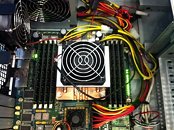- Joined
- Oct 9, 2007
- Messages
- 47,878 (7.38/day)
- Location
- Dublin, Ireland
| System Name | RBMK-1000 |
|---|---|
| Processor | AMD Ryzen 7 5700G |
| Motherboard | Gigabyte B550 AORUS Elite V2 |
| Cooling | DeepCool Gammax L240 V2 |
| Memory | 2x 16GB DDR4-3200 |
| Video Card(s) | Galax RTX 4070 Ti EX |
| Storage | Samsung 990 1TB |
| Display(s) | BenQ 1440p 60 Hz 27-inch |
| Case | Corsair Carbide 100R |
| Audio Device(s) | ASUS SupremeFX S1220A |
| Power Supply | Cooler Master MWE Gold 650W |
| Mouse | ASUS ROG Strix Impact |
| Keyboard | Gamdias Hermes E2 |
| Software | Windows 11 Pro |
Researchers at Intel have begun ground work on many-core processors that could drive ultra-mobile devices (such as tablets, smartphones, Ultrabooks, etc.,) in the near future. It design calls for no less than 48 processing cores on a piece of silicon, built on the "single-chip cloud computer" (SCC) design. The new technology could reach the markets anywhere between five to ten years from now, probably since current silicon fabrication technologies aren't advanced enough to put that much processing power into a chip that runs off a smartphone battery.
"If we're going to have this technology in five to 10 years, we could finally do things that take way too much processing power today," said Patrick Moorhead, an analyst with Moor Insights and Strategy. "This could really open up our concept of what is a computer... The phone would be smart enough to not just be a computer but it could be my computer." With devices like Microsoft Surface, which transform from a tablet to a fully-functional desktop with a dock, or a notebook with the flip of a smart cover, the definition of what constitutes a personal computer is changing. In a few years, your mobile could transform into a computing device of any shape and size for consumers.

View at TechPowerUp Main Site
"If we're going to have this technology in five to 10 years, we could finally do things that take way too much processing power today," said Patrick Moorhead, an analyst with Moor Insights and Strategy. "This could really open up our concept of what is a computer... The phone would be smart enough to not just be a computer but it could be my computer." With devices like Microsoft Surface, which transform from a tablet to a fully-functional desktop with a dock, or a notebook with the flip of a smart cover, the definition of what constitutes a personal computer is changing. In a few years, your mobile could transform into a computing device of any shape and size for consumers.

View at TechPowerUp Main Site








